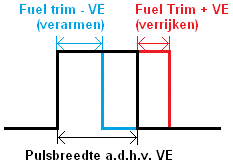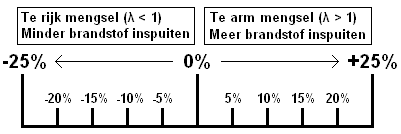Subjects:
- Oxygen sensor
- Heating element
- Measuring at the oxygen sensor
- Lambda values for a homogeneous and layered combustion process
- Fuel trims
Lambda probe:
Every modern car with a petrol engine and EOBD has 1 or 2 oxygen sensors mounted in the exhaust. Often a control sensor before the catalytic converter (a wideband sensor), and a control sensor after the catalytic converter (jump sensor). When only one oxygen sensor is present (in front of the catalytic converter), it is in most cases a jump sensor. The jump sensor is also called a zirconium sensor. The image below shows the front and rear oxygen sensor of cylinder bank 1 (numbers 1 and 2) and of cylinder bank 2 (numbers 3 and 4).
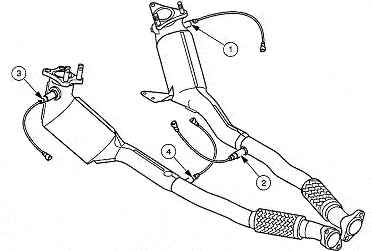
The oxygen sensor monitors the composition of air and fuel in the exhaust gases. The data from the measurements is sent to the engine control unit. The oxygen sensor is necessary for the catalytic converter to function, as it works with a mixture that regularly alternates between rich and poor. The control probe actually "controls" the mixture composition; the engine control unit receives the measurement data from the control probe and adjusts the injection accordingly. If the mixture was too lean, more fuel is injected. If the mixture is too rich, the injection time of the injector will be shortened to make the mixture leaner again.
When a vehicle is equipped with two sensors, the jump sensor registers the oxygen content in the exhaust gases after the catalytic converter; this checks whether the catalytic converter has converted the exhaust gases properly. If the catalytic converter is defective (eg when the interior is defective or purely due to aging), the jump sensor will recognize the malfunctioning of the catalytic converter. The engine fault light is then activated. When the car is scanned, a trouble code will appear informing you that the catalytic converter is malfunctioning. A oxygen sensor often lasts around 160.000 km. When a oxygen sensor becomes obsolete, the measurement results can be affected without an engine fault light coming on.
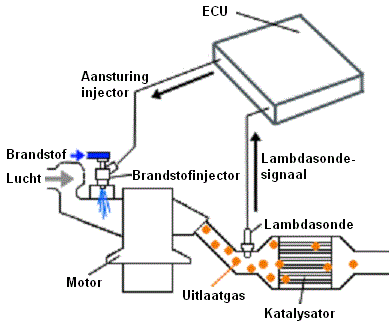
The injection system page explains how the mixture composition affects the exhaust gases, power and fuel consumption.
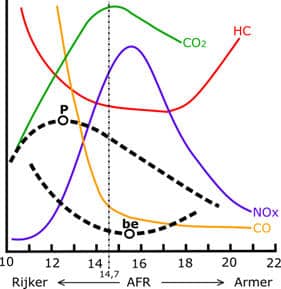
The oxygen sensor compares the exhaust gases with the outside air. It is therefore important that the outside air supply in the probe is not blocked. When this hole is closed and no more air (blue in the image below) can enter the sensor, the sensor will not work.
Heating element:
Modern oxygen sensor are equipped with an internal heating element. This heating element ensures that the oxygen sensor can start measuring as soon as possible after the cold start. The oxygen sensor only functions when the exhaust gases have reached a temperature of approximately 350 degrees Celsius. By heating the oxygen sensor internally, it is already possible to measure when the exhaust gases have reached half of the originally required temperature. Instead of a few minutes, you can now run in a closed-loop situation in a few seconds.
Wideband sensor:
The wideband sensor has a larger measuring range than the jump sensor. Also at full load, when the mixture is rich, the correct air/fuel ratio is recorded and sent to the ECU. Not only is the measurement accuracy high, but the sensor is fast and can withstand high temperatures (up to 950-1000°C). The image below shows the schematic of the wideband sensor.
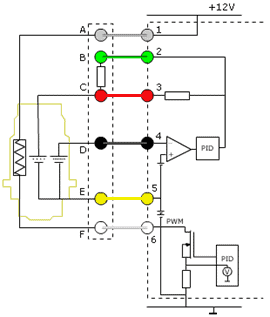
The wideband sensor must be at least 600°C in order to function properly. That is why a heating element (between the AF connections) is also used, which warms up the sensor after a cold engine start. The wideband sensor consists of a conventional zirconium sensor and a pump cell. The sensor is placed between connections D and E, and the pump cell is placed between C and E. The output voltage of zirconium sensor depends on the lambda values:
- Arm: 100mV;
- Rich: 900 mV.
The pump cell in the broadband sensor tries to keep the voltage constant at 450 mV by pumping oxygen to or from the outlet. In a rich mixture, the oxygen content is low, so the pump cell must pump a lot of oxygen to maintain the voltage of 450 mV. With a lean mixture, the pump cell pumps the oxygen away from the measuring cell. This changes the direction of flow used by the pump cell.
The current generated during pumping is measured. The height and direction of the flow is a measure of the actual air/fuel ratio. The control unit (the part to the right of the dashed line in the above figure) operates the pump cell. The voltage at point 4 depends on the value that the oxygen measuring element transmits. This voltage arrives at the negative terminal of the opamp in the control unit.
- Rich mixture: The voltage on the minus terminal of the opamp is higher than on the plus terminal. The amplifier is grounded and the output voltage will drop. A current flows from E to C.
- Lean Mix: The voltage on the negative terminal of the op amp is below 2,45 volts, which will put the amplifier at 4 volts and the output voltage will go up. A current will flow from C to E. In this case, the flow direction is reversed compared to the rich mixture.
The control unit can determine the current by measuring the voltage drop across the resistor at terminal 3. The magnitude of this voltage drop is the measure of the lambda value. Therefore, the jump sensor voltage cannot be checked with a multimeter to verify that the sensor is still functioning properly.
Jump sensor:
The jump sensor has a limited measuring range. Older cars with only a lambda sensor in front of the catalytic converter are often equipped with a jump sensor as a control sensor. The jump sensor generates a voltage based on the oxygen difference. This voltage is between 0,1 and 0,9 volts and can be measured with a multimeter.
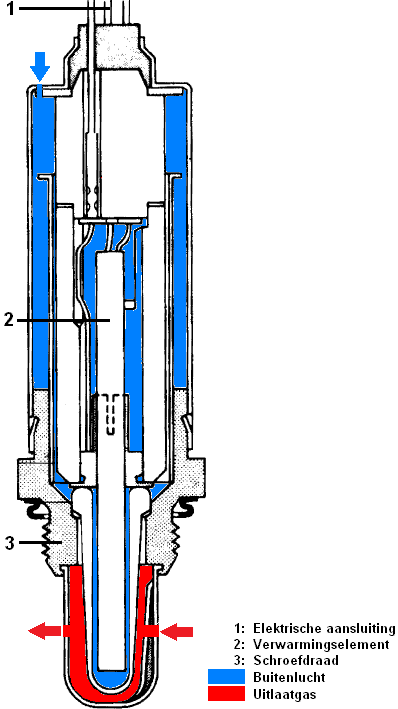
Lambda values for a homogeneous and layered combustion process:
Homogeneous:
With a homogeneous mixture, the lambda value is everywhere 1. That means with a petrol engine that the ratio of air and fuel is 14,7:1 (14,7 kg of air with 1 kg of fuel). Any motor can run homogeneously. If it is enriched, the lambda value will decrease and if the mixture is made leaner, the lambda value will increase:
λ<1 = Rich
λ>1 = Arm
An engine will always fluctuate between rich and poor to keep the catalytic converter working properly.
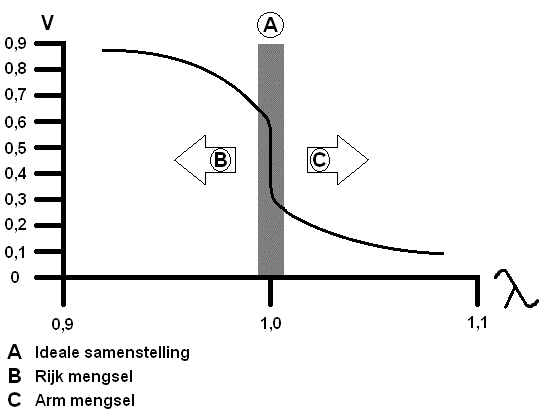
Layered:
Direct injection engines can run stratified at part load. A layered combustion process means that there are various layers of air in the combustion chamber that are used during combustion. Close to the spark plug the lambda value is 1. Further away from there the lambda value gets higher and higher (leaner, so more air). This air provides an insulating layer of air. In a layered process the injection time is later than in the homogeneous process.
With the help of a layered injection, the gas valve can be fully opened, so that it throttles the air less. Because the sucked in air is unclogned, it experiences less resistance and can therefore be sucked in more easily. Because the lambda value in the combustion chamber with the layered injection is still smaller than 1 due to the insulating air layer, this does not cause any problems with combustion. During the layering process, fuel consumption decreases.
At full load, the engine always runs homogeneously. This gives a higher torque than with a layered process. If the engine runs homogeneously, the fuel is injected early. The engine also runs homogeneously when starting from a standstill. A higher starting torque is then present than if the engine were running in layers
fuel trim:
Fuel trims are formed from the oxygen sensor data. The fuel trims are used on a gasoline engine to maintain the ideal air/fuel ratio for complete combustion. This amounts to 14,7 kg of air to 1 kg of fuel and we call this the stoichiometric mixing ratio.
Fuel trims provide a correction factor to adjust the base amount of fuel injected when needed. The wear and contamination of engine parts, sensors and actuators is taken into account. With the help of the fuel trims, the exhaust gas emissions over the entire life cycle of the car are kept within the legal standards.
For more information visit the page: fuel trim.
